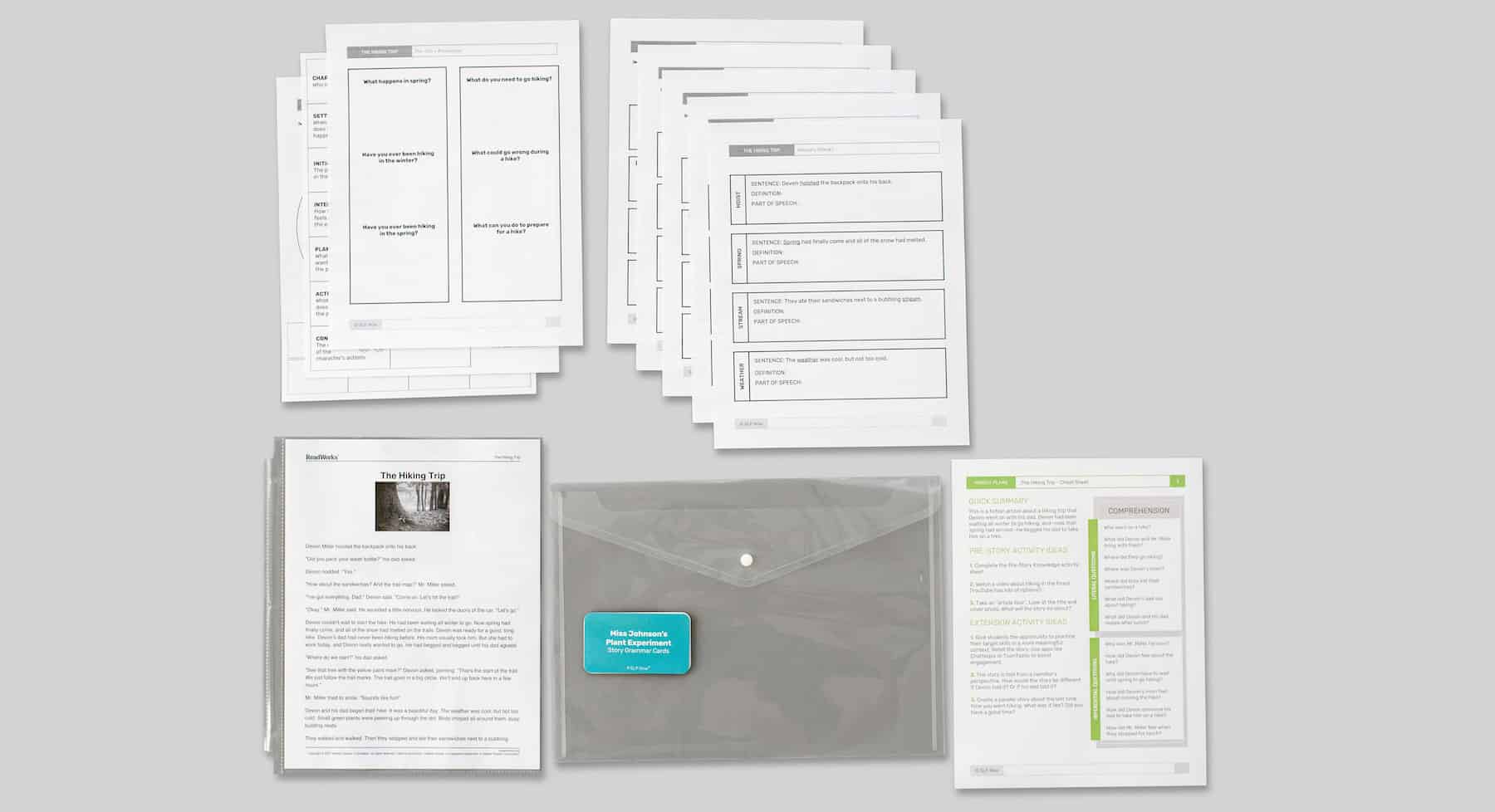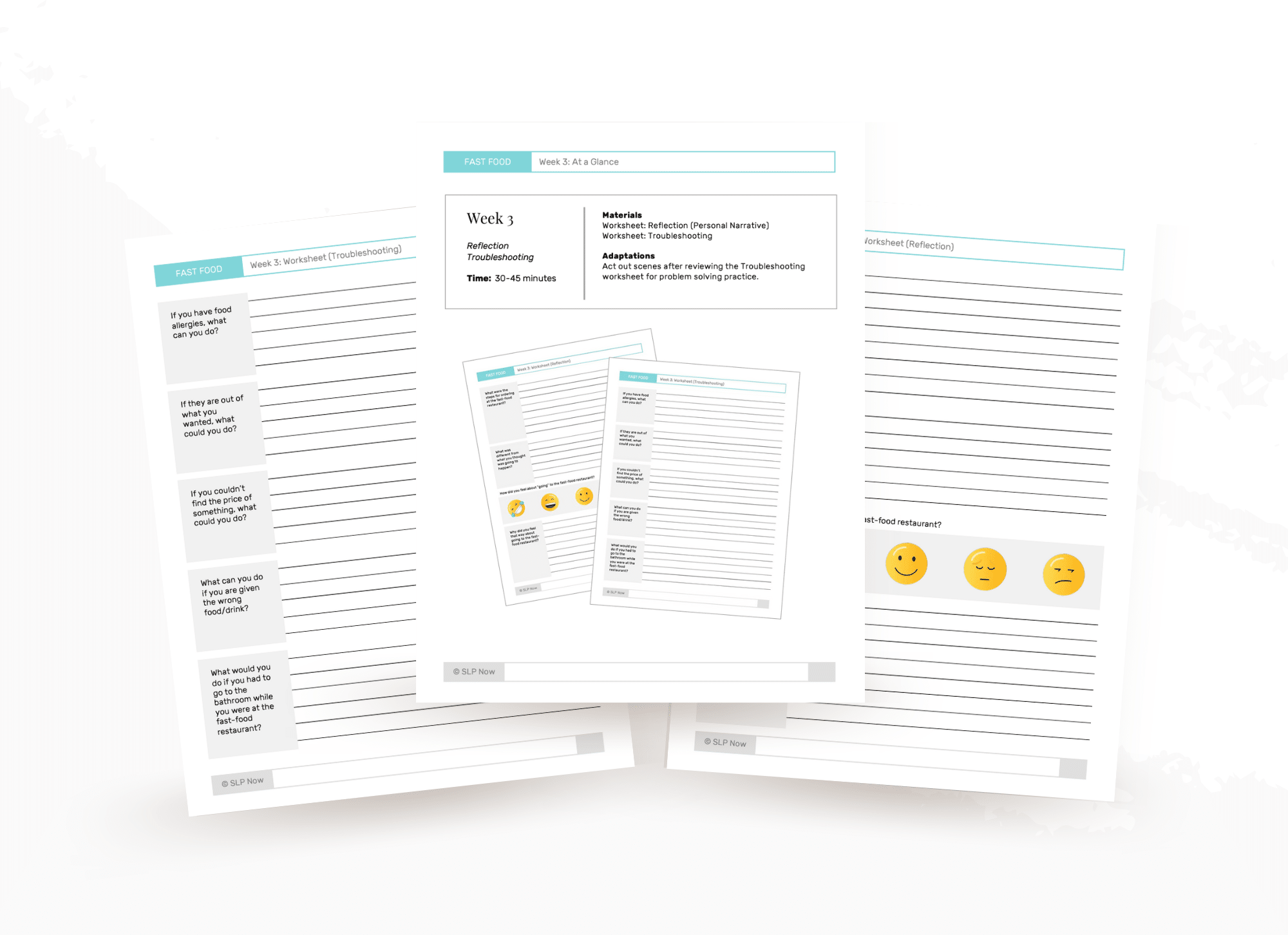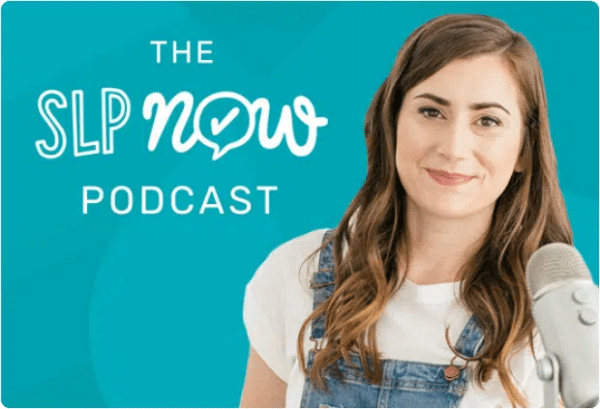Listen on Apple Podcasts Listen on Spotify
Welcome to another episode of the SLP Now podcast! We’re on the last of our six-week series about planning a month of literacy-based therapy, with units that will meet the needs of your entire school-aged caseload!
So far, we’ve used Dr. Ukrainetz’s five step literacy-based therapy framework to work through a month of therapy planning for five units: a play-based early language unit, a picture book, a fiction article, a non-fiction article, and a science experiment.
Today, we’re taking the final step on our therapy planning journey with a month of plans for a vocational unit!
This unit is ideal for students who are working on functional communication skills, and using language in “real world” situations versus a classroom environment.
For these plans, we’re going to use a unit from the SLP Now membership that’s all about ordering fast food! We chose this unit because it’s something that students are very motivated by, and it’s a lot of fun to work with.
Now let’s dig in! 🍔🥤
🍽️ Not sure which unit best suits your caseload? No problem!
Take a quick two-minute quiz, and we’ll send you a personalized list of recommended units based on your specific caseload needs — plus resources to help you implement the activities we talk about in this series.
Click here to get your recommended therapy plans
Speech therapy plans for a vocational video unit
We use Dr. Ukraintez’s literacy-based therapy framework as a guide for our vocational units, but they’re set up a little bit differently than the text-based units. This one is broken down into four weeks of activities: planning and preparing, modeling videos and acting it out, reflection and troubleshooting, then discussion activities.
There’s a wide range of activity options to explore, and you can use these materials and activities to target a variety of goals—like syntax, vocabulary, narratives, sequencing, and more!
Remember: It’s up to you to use your clinical judgment when you’re planning sessions.
We create our therapy plans to cover a month of activities, but you can move through the steps at the pace that works best for your students’ needs. You are the expert of your caseload! 🙌
Week One: Planning and Preparing
Find out what students need to know, and build knowledge to access the activity.
This step has a lot of overlap with step one of Dr. Ukraintez’s framework: Pre-story knowledge activation. It’s important to gather that background information so that you know how much your students understand about the subject matter before getting into skill practice.
You can prepare students by introducing the topic and giving an overview of the unit. Ask your students some questions to find out how much they know about ordering fast food, and talk through the content on the activity pages:

Having concrete data about your students’ background knowledge goes a long way towards setting them up for functional communication success. And, doing that groundwork now will make those future activities—like problem solving—a little easier.
If your students struggle with that foundational knowledge, you can fill the gaps with some of the activities we’ve used in our literacy-based units—like a virtual field trip!
🍟 Head to our Instagram and comment “FAST” on this post if you want a link to the virtual field trip for this unit, plus some other therapy plan goodies!
Week Two: Modeling and Acting it Out
It’s time to put it into action!
When we were creating the plans for this unit in the SLP Now membership, we hired secondary students to help us make the modeling video that’s included. We recorded them ordering fast food so we would have a really good example of pure modeling to work with.
Once the students have watched the pure model videos, they get to act out their own scenario. They can recreate the conversations from the videos using the supplied scripts, or create their own! Either way, this step gives them the opportunity to work on those functional communication skills in a super practical way.
💡 All of the materials in this post are included with an SLP Now membership.
Already a member? Access your plans here
Not a member? Not a problem! Start your free trial today
Week Three: Reflection and Troubleshooting
Ask questions about the activity
While you don’t need to use the worksheets in SLP Now for this step, we are big fans of them. This purpose of this section in the unit is to ask your students questions that are focused on reflection and application to build comprehension, and target some problem-solving skills, and the worksheets have some great ideas for questions. Of course, you can also write your own!
Whatever works best for you and your students is the right activity choice.

Week Four: Discussion Activities
Let’s talk about it together!
In this step, students have the chance to dive into the topic a little further. This helps to encourage generalization and discussion. It’s also a great time to add an extension activity!
You can support the students in creating a project that’s inspired by the unit they completed, like recording a video of them acting out the script to watch back later, or have the students write about their favorite fast food restaurant and why they love it so much.
The activities in this unit are language rich (as always!) so you can target a ton of language goals—but they’re also great for working on executive function skills, sequencing, perspective taking, and more! There are so many functional exchanges in the actual scenarios, and students can work on creating personal narratives in their reflection.
These plans you’ll also include a troubleshooting section to work on critical thinking and problem solving, plus plenty of opportunities to compare and contrast.
This vocational unit is full of great functional communication activities! 💪
💌 If you have any questions or are struggling to implement this unit with your students, send Marisha a DM on Instagram! She’d love to hear from you.
Bonus: Focused Skill Activities
Introduce new skills and provide structured practice.
This step wasn’t mentioned on the podcast episode, but it is step five of Dr. Ukrainetz’s literacy-based framework—and hey, if the worksheets exist, you might as well use them!
If the ideas mentioned above aren’t providing the targeted skill practice that your students need, using worksheets or other focused activities are a great way to get the necessary exposures.

And that’s a wrap on our six-week series about plans to cover a month of therapy! This was so much fun for us to create, and we hope that you had just as much fun learning with us.
We love nerding out on the evidence with you, and, we love getting creative about therapy plans + working smarter! We’re so grateful to share those loves with an incredible community of SLPs… including you. 🥰
Next up—we’re going to shift gears from therapy planning to speech room organization because there’s nothing like a little spring cleaning before school’s out for the summer!!
Links and Additional Resources
- Dr. Ukrainetz’s five step literacy-based therapy framework
- #183: A Month of Therapy Using an Early Language Picture Book
- #184: A Month of Therapy Using a Picture Book
- #185: A Month of Therapy Using a Fiction Article
- #186: A Month of Therapy Using a Nonfiction Article
- #187: A Month of Therapy Using a Science Experiment
At SLP Now, we are hard workers… but we also like to work smarter.
That means we’re constantly improving our materials, therapy planning resources, and the ways we support SLPs like YOU — so you can skip the hard work part and just work smarter. 👇
Inside the SLP Now membership, you’ll find 400+ therapy plans and an organized library of 4,500+ (and counting!) evidence-backed speech therapy materials to help you differentiate your therapy in a matter of minutes.
How is that possible, you ask?
Because we analyzed all the books, identified the targets, and created unit plan pages that suggest activities based on the skills you’re targeting and your students’ needs. This is the one stop shop for all your literacy-based therapy needs, including resources for virtual field trips and visuals to help those concepts stick.
We’ve talked about so many activity options during this series… but there are even more literacy-based ideas and evidence-based resources waiting for you on the other side of SLP Now. 🤗
Join thousands of SLPs and get the support you need
Sign up for a risk-free two week trial → We won’t even ask for your credit card!
Subscribe
Subscribe to the SLP Now podcast and stay tuned for our next series. We’re kicking off September by helping you get your data collection, paperwork, and therapy planning processes in tip-top shape!

Listen to The SLP Now Podcast on Apple ★ Spotify ★ Google ★ Stitcher ★ Castbox or wherever you listen to podcasts.
Transcript
00:00
Hello there, and welcome to the SLP now podcast, where we share practical therapy tips and ideas for busy speech language pathologists. Grab your favorite beverage and sit back as we dive into this week's episode.
00:19
This week we are diving into our last unit type.
00:24
We are wrapping up the six week.
00:26
Series, and today we are going to walk through a vocational video unit. And so this unit is ideal for students who are working on more of that functional communication and using language in very functional scenarios. This is an example of a unit.
00:50
In SLP now, and it is all about ordering fast food, which is a.
00:58
Super motivating activity for a lot of.
01:00
Our kiddos, and it is a great.
01:03
Functional activity for them to use their language in a very functional way. So how the unit is set up, it's broken down into four weeks of activities.
01:17
And of course you can use your.
01:19
Clinical judgment to adjust things, but in week one, it's all about planning and preparing.
01:25
So we have some activity pages that.
01:28
Will help students plan and prepare for.
01:33
The actual fast food ordering activity. If I were using this in week two, I would show the students the.
01:42
Modeling video that's included with the unit.
01:45
So we hired secondary students to record.
01:50
All of these functional scenarios for us.
01:53
So we recorded them ordering fast food.
01:57
So it's a really great example of peer modeling. And then once they watch the peer.
02:03
Model videos, then they get to act out their own scenario. And then in week three, there are.
02:11
Some activities around reflection and troubleshooting. And then week four includes some discussion activities.
02:19
These are language rich activities, as always.
02:24
But they're really great for targeting executive function skills, sequencing, perspective taking. Again, like I said, lots of functional.
02:33
Communication in the actual scenarios, and they.
02:39
Can work on creating personal narratives in their reflection. There is a troubleshooting section, so they can work on critical thinking, problem solving.
02:49
And there's also some opportunities for compare.
02:53
And contrast within the activities.
02:56
So as you can see, this is.
02:59
A great functional communication activity, and we can also use it to target a.
03:05
Variety of goals from syntax, vocabulary, narratives.
03:11
All of that good stuff. So it's got a really nice range of activities.
03:16
It's structured kind of similar, inspired by.
03:20
A literacy based therapy unit. So when we're planning, we kind of have some pre story.
03:26
Well, it's inspired by the pre story.
03:28
Knowledge activation step from our literacy based.
03:31
Therapy framework, the one developed by Doctor Ukranitz. It asks them about, like what they.
03:37
Know about fast food. Like, have they been to a fast food restaurant? And kind of gathering that background knowledge and that background knowledge will be really helpful.
03:48
Once we have, like, the concrete facts, it'll make it really easy to help students use that functional communication and do that problem solving because we've done all of those steps ahead of time. And like I said, we have the.
04:05
Modeling video where the student gets to.
04:08
See peers in that scenario.
04:12
And then there's a video modeling script so you have easy access to the script if your students would like to use that, or they can create their own.
04:22
And again, there's so many language opportunities here. It's hard to get super specific because.
04:28
There'S so many goals that you could target, and there's such a wide range of students that you can use this with. But if you have any questions or.
04:36
You'Re struggling to think about how you might use this with some students, send.
04:41
Me a DM on instagram.
04:42
I'd love to hear from you, but yeah, so that is an overview of.
04:48
The different activities that you can use in conjunction with this unit.
04:53
And like I have mentioned in the.
04:56
Previous unit, if you'd like to check.
04:58
Out this unit, if you are already.
05:01
An SLP now member, just go to.
05:03
The therapy plans tab on the SLP now site and then type in fast food and just click.
05:10
And then you'll have instant access to this therapy plan, including the video and the interactive resources.
05:16
All of that good stuff. And if you're not a member yet.
05:20
Go to slpnow.com unit. That'll send you to our free trial page. And all you have to do is enter your name and email and a quick password so that you can log in.
05:32
You can also go to therapy plans tab.
05:34
Check out the 400 plus units, including this one.
05:39
Kind of see if it would be.
05:41
A good fit for you.
05:42
And yeah, that is a wrap on.
05:46
Our vocational video unit.
05:49
Like I said, don't hesitate to reach.
05:51
Out with any questions. I'd love to hear from you and I hope your week is off to a fabulous thanks for listening to the SLP now podcast. If you enjoyed this episode, please share with your SLP friends. And don't forget to subscribe to the podcast to get the latest episodes sent directly to you. See you next time.
Sign up to receive email updates
Enter your name and email address below and I'll send you periodic updates about the podcast.

